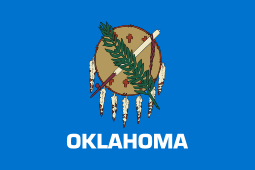Oklahoma Energy Resources Board
| Agency overview | |
|---|---|
| Formed | January 1, 1993 |
| Headquarters |
3555 NW 58 Street Oklahoma City, Oklahoma |
| Employees | 10 unclassified |
| Annual budget | $15.7 million |
| Ministers responsible |
|
| Agency executive |
|
| Website | Oklahoma Energy Resources Board |
The Oklahoma Energy Resources Board (abbreviated OERB) is an agency of the state of Oklahoma. Funded voluntarily by Oklahoma's oil and natural gas producers and royalty owners, OERB conducts environmental restoration of orphaned and abandoned well sites, encourages the wise and efficient use of energy, and promotes energy education.[1]
The Board is composed of 21 members. 7 members are appointed by the Governor of Oklahoma, 7 are appointed by the President pro tempore of the Oklahoma Senate, and 7 appointed by the Speaker of the Oklahoma House of Representatives. All members are either independent oil or natural gas producers or representatives of major oil companies that do business in Oklahoma. The Board, in turn, appoints an Executive Director to serve as the chief administrative officer of the Board.
The current board chairman is David House, president of Jireh Resources, LLC in Tulsa, OK.
OERB was created by the Oklahoma Legislature and energy industry leaders in 1993 during the term of Governor of Oklahoma David Walters.
Mission
The stated missions of the Oklahoma Energy Resources Board are:
- to educate Oklahomans about the importance of petroleum (oil and natural gas) in their lives through traditional and non-traditional school curricula, advertising, and public relations
- to environmentally restore abandoned well sites to productive land use
- to promote environmentally sound production methods and technologies
- to research and provide educational activities concerning the petroleum exploration and production industry
Leadership
OERB is under the leadership of the Secretary of Energy, the Chair of the Board, and the Executive Director of OERB. Under Governor of Oklahoma Mary Fallin, C. Michael Ming serves as Secretary, David House serves as the Chairman and Mindy Stitt serves as the Executive Director.
Environmental restoration
Since its creation in 1993, the OERB has committed $69 million to restore more than 11,800 abandoned and orphaned well sites as part of its environmental restoration program.[2] It has made restoration progress in 67 of Oklahoma's 77 counties and has a restoration budget of $6 million for the current fiscal year.
Unique is OERB's funding process – though it is funded by a 0.1% assessment on oil and gas sales (not uncommon among similar agencies), it is a voluntary assessment. Any producer or royalty owner may opt out of the program by requesting OERB (between January 1 and March 31 of each year) for a refund of previously paid assessments. OERB states that over 95% of participants remain in the program.[3]
Education
Throughout its history, the OERB has reached more than 1 million Oklahoma students with energy curricula, classroom supplies, field trips, college scholarships and presentations. OERB reaches all academic grade levels – from kindergarten through college with its energy education programs, including:[4]
- The OERB Petroleum Scholar Program distributes up to $500,000 each year to Oklahoma college students majoring in petroleum-related fields. The deadline for these scholarships is March 1, 2012 and applications can be found at the official. OERB Petroleum Scholar page.
- The PetroTech Program provides training and certification for Oklahomans interested in Geo Tech, Land Tech and Engineering Tech positions within the oil and natural gas industry. Detailed information about the programs can be found at the official Petro Tech page. The Oklahoma Energy Resources Board created the PetroTech Program to help prepare Oklahomans for careers in the energy industry. A year after its inauguration, the program had accepted more than 400 students and industry employers are now hiring PetroTech graduates.[5]
- Petro Pros gives oil and natural gas professionals an opportunity to volunteer their time to visit classrooms and show children the science and business side of the industry.
- Little Bits is a kindergarten through second grade energy curriculum that introduces simple energy terms through games and reading. More than 1,200 teachers have been trained to teach this curriculum.
- Fossils to Fuel is an elementary school energy curriculum with nearly 7,000 teachers trained.
- Petro Active is a middle school energy curriculum with more than 1,600 teachers trained.
- Core Energy is a high school energy curriculum with more than 2,600 teachers trained.
- Museum Partnerships allow the OERB to partner with several museums across the state to enhance energy education curricula and provide free classroom field trips.
- The OERB uses Safety Videos to demonstrate the dangers of playing around well sites. The video entitled, "What's the risk" can be found at OERB's safety page
- Well Site Safety Day is an annual event at the State Capitol to spread awareness of well site dangers to children, parents and teachers.
Conservation
Through its Conservation Education Program, the OERB has contributed $1.75 million to help more than 800 Oklahoma families weatherize their homes and save up to 30 percent on their utility bills. In addition to providing weatherization assistance, the OERB provides tips on saving energy and money through advertisements, community events and a website, which includes a “Weatherize Your Home” video demonstration, conservation tips and information on how to apply for home heating assistance.
References
- ↑ http://oerb.com/about/funding.asp
- ↑ Well Site Cleanup
- ↑ "OERB". Retrieved 2 November 2016.
- ↑ http://oerb.com/education/student.asp
- ↑ "Find Stations and Donate : NPR". Retrieved 2 November 2016.
